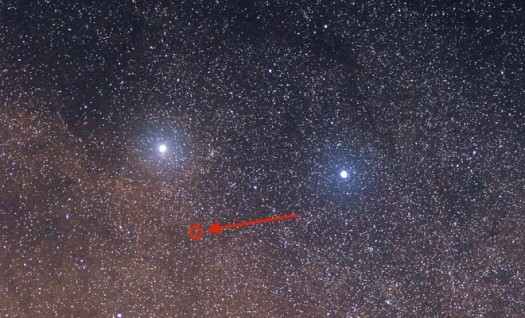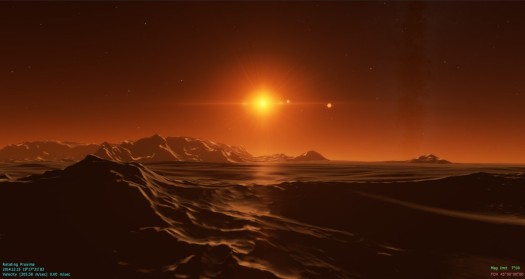
Astronomers have been trying for decades to find a planet orbiting Proxima Centauri, the star closest to our sun and so a natural and tempting target. Claims of an exoplanet discovery have been made before, but so far none have held up.
Now, in a novel and very public way, a group of European astronomers have initiated a focused effort to change all that with their Pale Red Dot Campaign. Based at the La Silla Observatory in Chile, and supported by networks of smaller telescopes around the world, they will over the next three months observe Proxima and its environs and then will spend many more months analayzing all that they find.
And in an effort to raise both knowledge and excitement, the team will tell the world what they’re doing and finding over Twitter, Facebook, blogs and other social and traditional media of all kind.
“We have reason to be hopeful about finding a planet, but we really don’t know what will happen,” said Guillem Anglada-Escudé of Queen Mary University, London, one of the campaign organizers. “People will have an opportunity to learn how astronomers do their work finding exoplanets, and they’ll be able to follow our progress. If we succeed, that would be wonderful and important. And if no planet is detected, that’s very important too.”

The name of the campaign is, of course, a reference to the iconic “Pale Blue Dot” image of Earth taken by the Voyager 1 spacecraft in 1990, when it was well beyond Pluto. The image came to symbolize our tiny but precious place in the galaxy and universe.
But rather than potentially finding a pale blue dot, any planet orbiting the red dwarf star Proxima Centauri would reflect the reddish light of the the star, which lies some 4.2 light years away from our solar system. Proxima — as well as 20 of the 30 stars in our closest neighborhood — is reddish because it is considerably smaller and less luminous than a star like our sun.
Anglada-Escudé said he is cautiously optimistic about finding a planet because of earlier Proxima observations that he and colleagues made at the same observatory. That data, he said, suggested the presence of a planet 1.2 to 1.5 times the size of Earth, within the habitable zone of the star.
“We did not and are not making claims in terms of having discovered a planet,” he said. “We’re saying that we detected signals that could mean there is a planet. This is why we’ve planned this campaign — to see if the signal is telling us something real.” He described the campaign as a “partnership between scientists involved in the observations and European Southern Observatory.”
Even without a previous signal, it’s a reasonable bet that Proxima does have at least one planet orbiting it. Based on the results of the Kepler Space Telescope survey in particular, there is a consensus of sorts in the astronomy community that on average, every star has at least one planet circling it.

Paul Butler, a pioneer in planet hunting at the Carnegie Institution of Washington who has done extensive observing of Proxima with his team at Las Campanas Observatory in Chile, will be providing data to the Pale Red Dot campaign. Proxima search results from the ESO’s Very Large Telescope at Paranal, Chile, will also be provided to campaign.
Butler said that in some ways Proxima “is the most exciting star in the sky. It’s the very nearest star and so the discovery of a planet there would be huge – front page of the paper around the world.”
What’s more, he said, such a discovery could be enormously helpful in motivating Congress and taxpayers to spend the money needed for what is considered the holy grail of planet hunting — building a space-based exoplanet observatory that could directly image exoplanets. “We have to give people a clear reasons to spend all that money and finding a potentially habitable planet around Proxima, that would be it.”

Proxima and the other Alpha Centauri stars are also an especially appealing target because they have loomed so large in science fiction. From Robert Heinlein’s “Ophans of the Sky” stories of crews traveling to Proxima to Isaac Asimov’s “Foundation and Earth ” set around Alpha Centauri and more recently to the James Cameron’s movie “Avatar,” also set in the Centauri neighborhood, these closer-by have been a frequent and logical destination.
While Alpha Centauri B has gotten much scientific attention in recent years with a reported but still unconfirmed and now often dismissed planet candidate, Proxima Centauri has been the object of much observation, too, and that has begun to define what kinds of planets might and might not be present.
So far, the work of Butler’s team has not found any particularly promising signs of a planetary-caused Proxima wobble. But he said nothing established so far about Proxima rules out the presence of a small planet relatively close to the sun — the very time-consuming observations needed to potentially detect that size planet just haven’t been done.
Similarly, the Very Large Telescope results ruled out the presence of Saturn-size planets with many-year orbits and Neptune-size planets with orbits less than about 40 day, and no planets more than 6 to 10 Earths in the habitable zone. This is actually promising news, since the absence of larger planets in the habitable zone leaves the field open for smaller ones.
Two other teams are now focused on Proxima as well. One is led by David Kipping of Columbia University using the Canadian Microvariability & Oscillations of STars space telescope (MOST) to search for transits. The other is led by Kailash Sahu of the Space Science Telescope Institute in Baltimore, using the Hubble Space Telescope for micro-lensing of the star. The stars are aligned for the microlensing event this month.

The Pale Red Dot observing began last week and will run for two and a half month using the High Accuracy Radial velocity Planet Searcher (HARPS) spectrograph at the European Southern Observatory (ESO) telescope at La Silla, Chile. The observations — like those made at the Magellan and at Paranal — look for tiny wobbles in the star’s motion created by the gravitational pull of an orbiting planet. (More on how the radial velocity method works, as well as other connections to and details about the campaign can be found at: https://palereddot.org/introduction/)
The campaign is the beneficiary of a substantial amount of HARPS observing time — 25 minutes of observing for 60 nights in a row — which is essential to confidently detect the presence of a small, Earth-sized planet.
Other robotic telescopes — including the Burst Optical Observer and Transient Exploring System, the Las Cumbres Observatory Global Telescope Network and the Astrograph for the Southern Hemisphere II — will participate. The role of these automated telescopes is to measure the brightness of Proxima each night, a backup that will help astronomers determine whether the wobbles of the star detected via radial velocity are the tug of an orbiting planet or activity on the surface of the star. Anglada-Escudé said that after a full analysis, the findings will offered to a peer-reviewed journal and published.
While the goal of the campaign is definitely to detect a planet orbiting our closest stellar neighbor, it is also very consciously a public outreach effort for astronomy and exoplanets. Everything about the campaign will be made public, and often immediately via Twitter and other social media. It will provide a window, said Anglada-Escudé, into how planet-hunting astronomy works.

“We think this to be a good way to explain things that are not obvious to the public, to show them that looking for planets is not always excitement and ‘eurekas.’ We’ll show life at the observatory, how our observations are made, what happens as we analyze the data. And if in the end we don’t find evidence of a planet, we will have shown how we search for such tiny objects so far away, and do it with a pretty amazing precision.”
Involving the public so early and often definitely brings risks, since the campaign could certainly come up empty-handed. But in terms of real-life planet hunting, that result is hardly unusual. An awful lot of planet-hunting campaigns end without a detection.
When red dwarf stars, also called M dwarfs, are found with orbiting planets, they tend to be much closer in than with more massive stars, and their habitable zones are also much more narrow. Initially, red dwarfs were not considered good candidates for habitable planets because they are so relatively small — between 50 to 5 percent the mass of our sun. Any planets orbiting close to a red dwarf would likely be tidally locked as well, with only one side ever facing the sun. The pull of the host star causes the locking.
These issues and more earlier led scientists to dismiss red dwarf exoplanets as unlikely to be habitable. That unpromising view has changed with the creation of models for tidally locked planets that could be habitable, and with the discovery of many exoplanets orbiting around the red dwarfs. These small suns actually constitute more than 70 percent of the stars in the sky, although very few of the ones you can see without a telescope.
So the time seems ripe for a substantial exoplanet campaign at Proxima — one that just might find a planet and that certainly has a lot to teach the public.
Sites where you can follow the campaign:
Twitter: @Pale_red_dot #palereddot
Facebook page: ‘Pale Red Dot’

